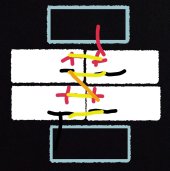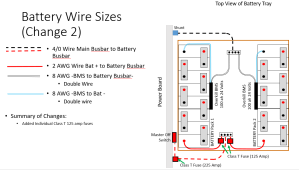Greetings,
I joined a couple of months ago and have been lurking and learning a lot ever since. This is a great forum. I have been off grid since I built my house over 25 yrs ago. I recently upgraded my system after deciding to make the plunge for LifePo4 batteries. I went from 12 volt to 24 volts, and I replaced my beast of a Trace inverter with the compact Victron Multiplus 24 3000/70. And I am finally done with lead acid batteries, having purchased 4 Ampheretime 12v 300 amp/hr LifePo4 batteries. I run Linux, not Windows, so it was very difficult configuring the Multiplus for LifePo4 batteries, but I finally got it with a lot of help from this forum and Oracle VirtualBox.
When I put my original system together, nobody was talking about using bus bars for the battery bank. Now it seems it's the only sure way to give batteries a chance to balance, so I'm going to try them. I’m pretty sure this setup will work, but I wanted some assurance and feedback.

Sorry for the crude sketch. The 4 batteries are configured 2s/2p for 600amphrs at 24 volts. I am going to use a 1/8 x 1 copper bar to tie the 2 batteries in series. The larger bus bars are 1/8 x 3”. On the ends of the bar I plan to have the leads to put the batteries in parallel. In the center I was planning to hook up the inverter. And between those 2, my leads for the Victron charge controller and my DC loads. I also have a Victron Smart Shunt. The only cable that will be used is for the parallel connections. I want to make them as short as possible, but that is the logical place for the smart shunt, right?. Is there a better place? What about my monitoring leads? Can I just put those with the parallel terminals, or should I create some smaller terminals in the bus bar for those?
The large bus bars are 24” long. I was thinking that I could get away with 18” for them, and use the remaining 6” for a stronger series connection bus bar. Do you think that is necessary? Or is the 1” wide enough?
Any comments or observations would be greatly appreciated.
I joined a couple of months ago and have been lurking and learning a lot ever since. This is a great forum. I have been off grid since I built my house over 25 yrs ago. I recently upgraded my system after deciding to make the plunge for LifePo4 batteries. I went from 12 volt to 24 volts, and I replaced my beast of a Trace inverter with the compact Victron Multiplus 24 3000/70. And I am finally done with lead acid batteries, having purchased 4 Ampheretime 12v 300 amp/hr LifePo4 batteries. I run Linux, not Windows, so it was very difficult configuring the Multiplus for LifePo4 batteries, but I finally got it with a lot of help from this forum and Oracle VirtualBox.
When I put my original system together, nobody was talking about using bus bars for the battery bank. Now it seems it's the only sure way to give batteries a chance to balance, so I'm going to try them. I’m pretty sure this setup will work, but I wanted some assurance and feedback.

Sorry for the crude sketch. The 4 batteries are configured 2s/2p for 600amphrs at 24 volts. I am going to use a 1/8 x 1 copper bar to tie the 2 batteries in series. The larger bus bars are 1/8 x 3”. On the ends of the bar I plan to have the leads to put the batteries in parallel. In the center I was planning to hook up the inverter. And between those 2, my leads for the Victron charge controller and my DC loads. I also have a Victron Smart Shunt. The only cable that will be used is for the parallel connections. I want to make them as short as possible, but that is the logical place for the smart shunt, right?. Is there a better place? What about my monitoring leads? Can I just put those with the parallel terminals, or should I create some smaller terminals in the bus bar for those?
The large bus bars are 24” long. I was thinking that I could get away with 18” for them, and use the remaining 6” for a stronger series connection bus bar. Do you think that is necessary? Or is the 1” wide enough?
Any comments or observations would be greatly appreciated.





